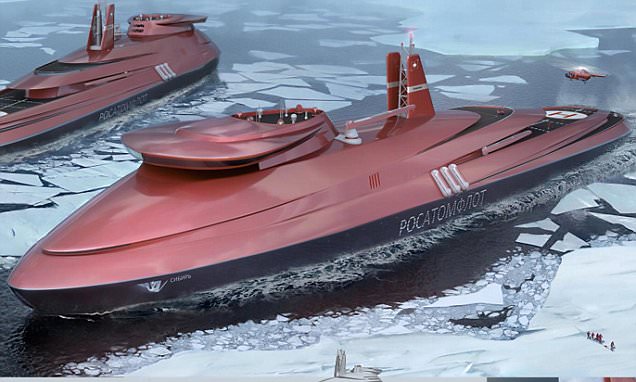
New Managing Director for Bellona Norway
The Board of the Bellona Foundation has appointed former Minister of Climate and the Environment Sveinung Rotevatn as Managing Director of Bellona No...
News

Publish date: February 1, 2018
News
Rumors continue to swirl around Russia’s newest nuclear icebreaker extravaganza, the Leader, an unlikely space age vessel of massive dimensions, three of which one high ranking government official says the country will build sometime within the next seven years.
As Moscow tells it, the only real question now is where it to build it. The bulk of Russia’s nuclear ice busting steel has for a half century been forged at the Baltic Shipyard in St. Petersburg. But this month a dark horse emerged as a possible contender, one that would suit the imperial nature of Russia’s newest icebreaker ambitions: Crimea.
The Leader (or Lider) project first emerged as an artist’s fever dream on the cover of a magazine put out by the country’s Unified Shipbuilding Corporation three years ago. The vessel was shown steaming through puffy islands of ice, its aerodynamic lines viewed from the vantage point of a helicopter about to alight on its deck. Far from the image of a powerful Arctic draught horse, the vessel seemed better suited as a yacht for one of Vladimir Putin’s billionaire friends.
 An artist's rendition of the Lider and its helipad. (Source: oaoosk.ru)
An artist's rendition of the Lider and its helipad. (Source: oaoosk.ru)
Leonid Rogozin, Russia’s mercurial deputy prime minister in charge of military affairs, put the wind in the project’s sails earlier this month by announcing plans to push out the three of the icebreakers between 2023 and 2025.
That’s no small feat. At 209 meters long and 47 meters wide, the Leader will be longer, wider, faster and stronger than the Arktika, the biggest icebreaker Russia is now operating. It will top by 50 meters even the three newline icebreakers the country is already building at $2 billion a piece, only two of which even yet have hulls.
 A mock-up of the bow of the Lider, as pictured in the Unified Shipbuilding Company's magazine.
Credit: oaoosk.ru
A mock-up of the bow of the Lider, as pictured in the Unified Shipbuilding Company's magazine.
Credit: oaoosk.ru
According to Rogozin, the new vessels doesn’t have a fixed price tag yet as the figure, he told the Tass news agency, will be calculated by a new “financial algorithm” designed to pay for the vessels.
With these questions settled, the only one remaining is where the mammoth Leader line will be developed. With the Baltic Shipyard’s dance card already filled by trying to punch out the Sibir, Ural and new Arktika icebreakers, which are behind schedule anyway, Rogozin has floated the notion of tooling up old military shipyards to do the job. Earlier this month, reports emerged that this might be the Zvezda yard in Russia’s Pacific Far East.
But last week, Komsomolskaya Pravda, a state approved tabloid popular with the Kremlin elite, ran a piece that was longer and more technical than its gossip column readers have come to expect, which extolled the virtues of the Black Sea’s Zaliv Shipyard in Kerch, Crimea.
 The 50 Let Pobedy icebreaker bringing politicians to the North Pole.
Credit: Murmansky Vestnik
The 50 Let Pobedy icebreaker bringing politicians to the North Pole.
Credit: Murmansky Vestnik
Directly after the annexation, Putin’s government called on “patriotic Russians” to take advantage of airfares the Kremlin had ordered slashed and go to Crimea for vacation. Many tens of thousands of Russians did – but most of them chose to drive, creating nightmare days-long traffic snarls on either side of the single ferry line operating between Kerch, Crimea and the Russian mainland.
In 2015, the Kremlin gave a multibillion dollar contract to the SGM Group, a construction firm owned by Putin’s long-time Judo partner Arkady Rotenberg, to build a bridge connecting the two points. But construction has been too slow to create the influx of Russians ripping down the peninsula’s Ukrainian flags that Moscow would like to see.
Enter the Zaliv Shipyard, which has created nothing of note aside from debt since the collapse of the Soviet Union in 1991. Andrei Zherdeyev, the plant’s general director, was keen to remind Komsomolskaya Pradva’s audience that Zaliv had experience with building at least one nuclear icebreaker – the Sevmorput, which, in Russian, is what the Northern Sea Route is called. All Zherdeyev’s shipyard needs, he told the paper, is tens of millions of dollars in investment in staff, training, and an across-the-board modernization of its equipment.
That might be a small price for the Kremlin to pay for a region it’s struggling to infuse with its DNA. Indeed, the coincidences of fate are too alluring to ignore. In characterizing his militant ambitions for the Arctic, Rogozin has often said nuclear icebreakers will help conquer the Northern Sea Route the same way Moscow conquered Crimea.
To do that, however, Moscow might first need to conquer Crimea – and it might be hoping the new icebreakers will help finish the job that that its phony referendum has not.

The Board of the Bellona Foundation has appointed former Minister of Climate and the Environment Sveinung Rotevatn as Managing Director of Bellona No...

Økokrim, Norway’s authority for investigating and prosecuting economic and environmental crime, has imposed a record fine on Equinor following a comp...

Our op-ed originally appeared in The Moscow Times. For more than three decades, Russia has been burdened with the remains of the Soviet ...

The United Nation’s COP30 global climate negotiations in Belém, Brazil ended this weekend with a watered-down resolution that failed to halt deforest...